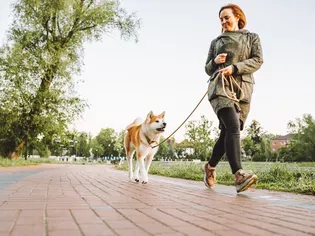How to Handle Your Dog Around People With Dog Phobias
Updated on 04/26/24

Navigating Canine Encounters: A Comprehensive Guide for Handling Your Dog Around People with Dog Phobias
As we navigate the complexities of sharing public spaces with our beloved canine companions, it's crucial to be mindful of those who may harbor a deep-seated fear of dogs, commonly known as cynophobia. This condition can manifest in various forms of anxiety, ranging from mild discomfort to severe panic attacks. Understanding the nuances of dog phobia and adopting appropriate strategies can ensure positive interactions for both parties involved.
Understanding the Roots of Dog Phobias
The origins of dog phobias are multifaceted and can stem from various experiences, including:
* Traumatic encounters: Negative experiences with dogs, such as bites or aggressive behavior, can trigger a lasting fear response.
* Learned behavior: Fear of dogs can be acquired through observation. Individuals who witness others expressing fear or anxiety around dogs may develop similar apprehensions.
* Genetic predisposition: Some studies suggest a genetic component to dog phobias, indicating that certain individuals may be more prone to developing this condition.
* Personality traits: People with an anxious or avoidant temperament may be more susceptible to developing phobias, including dog phobia.
Recognizing the Signs of Dog Phobia
Individuals with dog phobia often exhibit a range of physical and behavioral cues that can alert us to their discomfort:
* Avoidance: People with dog phobia will actively avoid any situation where they might encounter a dog.
* Anxiety: They may experience feelings of panic, nervousness, or shortness of breath.
* Physical symptoms: Physical manifestations of dog phobia can include trembling, sweating, heart palpitations, and nausea.
* Negative thoughts: Individuals may have intrusive thoughts about dogs, imagining worst-case scenarios and catastrophizing potential encounters.
* Cognitive distortion: People with dog phobia often overestimate the threat posed by dogs and underestimate their ability to cope with any interaction.
Creating a Safe and Respectful Environment
When encountering someone with dog phobia, it's essential to create a safe and respectful environment to minimize their anxiety:
* Keep your dog on a leash: This provides a sense of control for the individual and prevents any potential approach from your dog.
* Maintain distance: Allow ample space between your dog and the person with dog phobia.
* Ask for permission: Always seek consent before allowing your dog to approach anyone, even if they don't appear to have a dog phobia.
* Move slowly: Avoid sudden movements that could startle the person with dog phobia.
* Respect their boundaries: If the person requests more distance or indicates that they would prefer not to interact with your dog, respect their wishes.
Effective Communication Strategies
Open and empathetic communication is key to navigating interactions with people who have dog phobia:
* Introduce yourself calmly: Explain that you understand they may be uncomfortable around dogs and that you're taking precautions to ensure their safety.
* Use non-threatening language: Avoid using terms like "friendly" or "sweet" to describe your dog, as these words may trigger anxiety in someone with dog phobia.
* Listen actively: Pay attention to their concerns and respond with empathy and understanding.
* Offer reassurance: Let them know that you're there to support them and that you'll do everything you can to make them feel comfortable.
* Respect their decision: If they prefer not to interact with your dog, respect their choice and move on.
Additional Tips for Dog Owners
* Train your dog properly: Ensure your dog is well-behaved and obedient, as any misbehavior could worsen someone's dog phobia.
* Carry treats: Offering treats to the person with dog phobia can create a positive association with dogs.
* Consider professional help: If your dog's presence consistently triggers severe anxiety or panic attacks in individuals, consider seeking professional guidance to address the underlying phobia.
Examples of Effective Handling
Scenario 1:
You're walking your dog in the park when you notice a woman sitting on a bench with a look of anxiety. You approach her cautiously and introduce yourself.
"Hi, I noticed you may be a little uncomfortable around dogs. I'd like to assure you that my dog is friendly and well-trained. Would you mind if I kept my distance and walked by slowly?"
The woman hesitates for a moment before nodding. You maintain a respectful distance and walk past calmly. The woman relaxes slightly, grateful for your understanding.
Scenario 2:
You're visiting a coffee shop with your dog and see a man sitting alone. As your dog approaches him, the man visibly tenses up and moves away.
"Excuse me, sir," you say. "I realize my dog's presence may be making you uneasy. Would you be more comfortable if I moved to a different table?"
The man sighs with relief. "Thank you," he says. "I appreciate that." You relocate to another table, allowing the man to enjoy his coffee in peace.
By following these guidelines and embracing an empathetic approach, we can foster positive interactions and create a more inclusive environment for everyone, regardless of their fears or apprehensions.
Explore More Pets

Basic Training
Puppy and Baby Introductions

Working Dog Breeds
All About Search and Rescue Dogs

Dog Treatments
Puppy Vaginitis: Signs, Causes and Treatment

Dog Adoption
After More Than 1,200 Days in the Shelter, Coco Goes Home

Basic Training
How to Train Your Puppy to Go on Potty Pads

Hybrid Dog Breeds
The Difference Between a Mutt, Mixed Breed, or Designer Dog?

Dog Treatments
Nail Problems in Dogs

Puppies
7 Reasons Why Two Dogs Are Better Than One